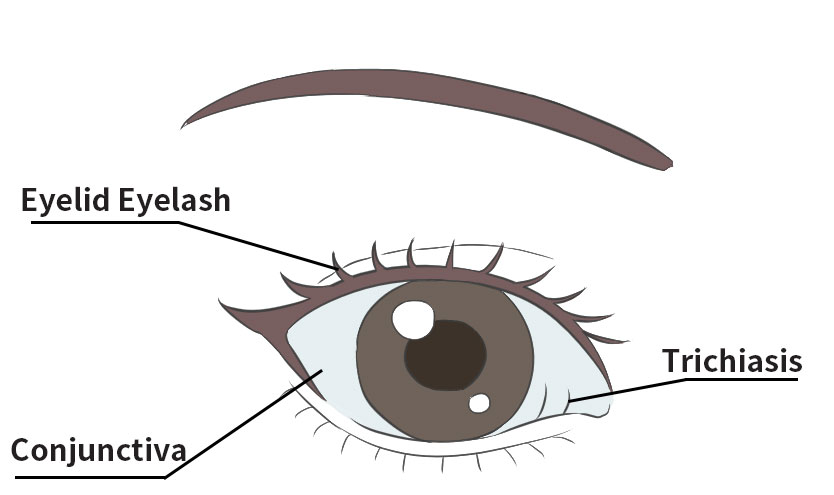Cleaning Validation Swabs: Ensuring Hygiene and Quality in Industrial Processes
239In industries where strict hygiene and quality control are of utmost importance, such as pharmaceuticals, food and beverage, and electronics, clean...
View detailsSearch the whole station Pandemic Supply
In addition to beautifying the eyes, eyelashes also serve as a light shield and a dust barrier. Under normal circumstances, the eyelashes of the eye grow forward and relatively away from the eye’s surface. Trichiasis is the opposite.

Trichiasis is a condition in which the eyelashes come into contact with the eyeball due to abnormal growth direction of the eyelashes, causing them to irritate the conjunctiva and cornea, and causing congestion, foreign body sensation, tearing and increased discharge from the eye. Trichiasis is one of the most common external eye diseases in ophthalmology and can occur at any age in young people, infants, and the elderly.
Most often seen in infants and children, there are two main causes of congenital lid entropion trichiasis: first, the pediatric nasal root is flat and not fully developed, and the inner canthus pulls, which can cause the lower eyelid to turn inward against the nasal side. The second is caused by overdevelopment of the orbicularis oculi muscle within the eyelid of the child and poor lid development.
Spastic entropion occurs mainly in the lower lid due to spasms of the orbicularis oculi muscle and may be caused by conjunctivitis, conjunctival foreign body, and keratitis stimulation. Long-term bandaging is also a causative factor and is called inflammatory spastic entropion.
It is also known as degenerative inversion of the face and is mostly seen in middle-aged and older adults. Its appearance is related to the relaxation of the soft tissues of the lower lid as the body ages. It is caused by atrophy of the orbital tissues, reduced fat, and inadequate support for the eyelid.
It is mainly caused by conjunctivitis, trachoma, chemical burns of the cornea, eyelid scarring, and eyelash reversal to the eyeball, which can also cause trichiasis.
Trichiasis can be removed with eyelash tweezers when the number of trichiasis is small, but they may reappear after a few weeks.
If the number of trichiasis is only 3-5, electrolysis can be performed. Electrolysis destroys the hair follicles and removes them, sometimes requiring several iterations to achieve the desired result.
Freezing destroys the hair follicles, so the trichiasis will not regenerate and can relieve numerous ingrown eyelashes. However, potential complications include loss of skin pigmentation, postoperative lid margin notching, damage to the lid glands and effects on the stability of the tear film.
Laser detachment is effective for a few scattered distributions of trichiasis.
The surgeon can remove the hair follicles under direct microscopic vision. If you have much trichiasis, wedge excision or anterior laminar excision can be effective for localized clusters of trichiasis that other methods cannot treat.
Pay attention to eye hygiene, and do not rub your eyes with your hands. Especially for children, parents must take care of them after surgery and pay attention to their hand hygiene to prevent them from scratching the eyelid skin with their hands and causing the eyelid wound to open.
The regular medication is under the guidance of the doctor.
You should not eat spicy food, go to bed early and get up early, and do not stay up late, and exercise more to strengthen your resistance.
The doctor will decide to remove the stitches according to the healing condition of the incision. After the stitches are removed, creams can be applied during 1-3 months according to the doctor’s advice to prevent infection and reduce scar formation.
“HCY, Health care for you” is our forever mission. We dedicate to offering safe & reliable products and medical services with our global creditable partners. HCY has already supplied to WHO, MAYO clinic, MGI, DDC, Yale University, Qorvo, Quanterix, Thomas Scientific, SD biosensor, Cardinal Health, Cleveland Clinic, Mars Petcare & LumiraDx, etc. in the past years.
In industries where strict hygiene and quality control are of utmost importance, such as pharmaceuticals, food and beverage, and electronics, clean...
View detailsTOC sampling verification is a process of evaluating the cleaning effect or whether the environment, samples, etc.
View detailsDisinfection before surgery is crucial. The purpose is to kill microorganisms on the surface and deep layers of the skin in the surgical area and minimize the risk of infection at the surgical sit...
View detailsWash Hands: Before using the CHG swab, the person applying it (usually a healthcare provider) should wash their hands thoroughly with soap and wat...
View detailsWe value your privacy We use cookies to enhance your browsing experience, serve personalized ads or content, and analyze our traffic. By clicking "Accept All", you consent to our use of cookies.
Our Privacy Policy